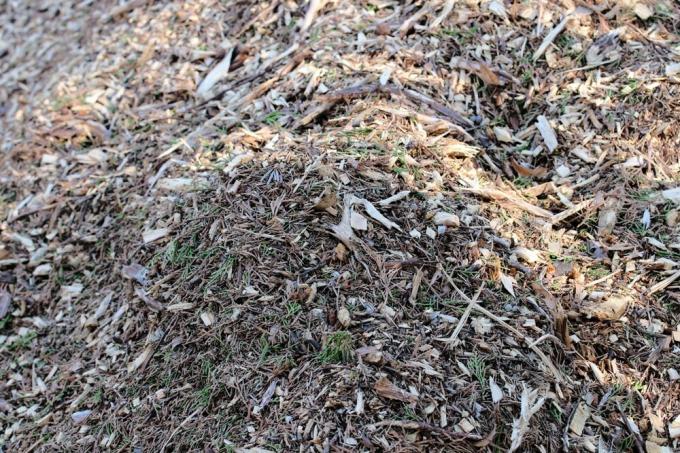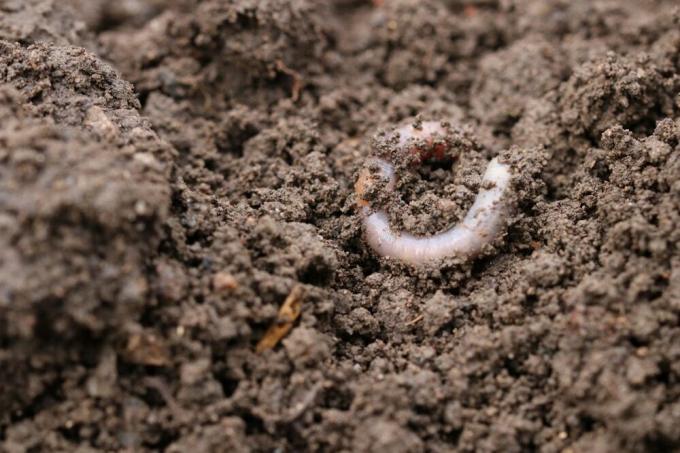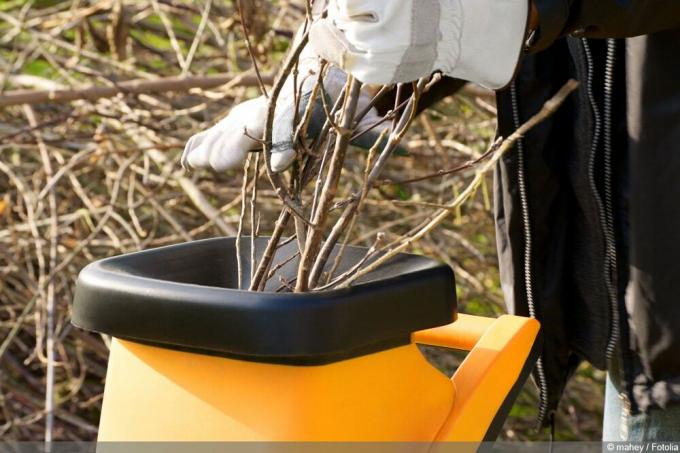

Table of contents
- composting
- Are not suitable for the compost
- Are weeds allowed in the compost?
- Three alternatives for green waste
- Attention fallen fruit!
- acorns and chestnuts
- compost bin
- What to do with large quantities?
- burn garden waste?
- Disposal in the landscape?
- Never put everything away!
Where to go with all the green waste? Every garden owner knows this problem, because waste accumulates in the garden at any time of the year. Leaves, fallen fruit, fallen branches, withered blossoms, lawn clippings as well as tree and bush clippings must be disposed of. What can go on the compost? What belongs in the organic waste? Which waste can still serve well in the garden? We give the answers.
composting
If you have enough space, you should definitely create a compost. Composting is the ideal way to
- tidy up the garden and remove plant debris
- enable the recycling of organic raw materials
- to create a supply of nutrient-rich hummus
Tip:
By composting you are helping to protect the environment. With the self-produced humus you can almost do without peat. Bogs have to be drained in order to extract peat, which destroys valuable habitats. Composting is also very inexpensive because you have the fertilizer and soil conditioner directly in the garden and do not have to buy it.
Garden waste such as:
- shrub pruning
- withered flowers
- plant remains
- lawn clippings
- pruning
- vegetable waste
- fruit waste
- leaves
- acorns, chestnuts
- nuts
- pinecone
- shredded wood waste
- vegetable kitchen waste

A notice:
Tropical fruit peels can be composted, but they decompose much more slowly when treated with pesticides and wax. It is important to ensure a good mixture with other organic materials.
Are not suitable for the compost
leftover meat
They attract rats, stray animals and vermin.
parts of diseased plants
Certain plant diseases can spread to other plants via the compost. Burn the plant parts or dispose of them in organic waste.
ash
After combustion, the ash from wood and coal contains a high concentration of heavy metals. The heavy metals would get into the garden soil and the grown vegetables via the compost.
stable dung
Manure contains a high concentration of nutrients that can lead to over-fertilization and damage to your plants.
Are weeds allowed in the compost?
Garden owners are always faced with the question of whether weeds belong in the compost or not. Weed seeds often only rot when it is very hot. Whether the required temperatures can form in your compost depends, among other things, on the altitude. The desired heat is only generated in sufficiently high compost heaps. It is important to achieve optimal compost quality through frequent turning. Precomposters that destroy the weed seeds are suitable.
Simply covering the compost can significantly reduce weed proliferation. Most of the time, weeds spread through the seed flight onto the uncovered compost. They are then applied to the beds with excellent humus and find the best growing conditions.
Three alternatives for green waste
Green waste, i.e. branches, twigs, shrub cuttings, pine cones, chestnuts and acorns, has a lot of potential.
mulch
Not only can you compost it, it makes a great mulch. To do this, chop up the green waste and spread it generously over your beds. It improves soil quality and keeps weeds away.

raised bed
Green waste can be used to create raised beds. Raised beds are made up of green waste, chaff, leaves, compost and soil.
decoration
How often have you bought twigs or pine cones for the design of flower arrangements, wreaths and floral decorations in a craft shop? From now on, look out for decorative twigs, cones and branch discs in the green waste. The best craft materials can be found in your own backyard!
Attention fallen fruit!
Fallen fruit cannot be avoided. Try to pick it up off the ground quickly. The longer it is on the ground, the more pests are attracted to it.
Severely damaged fruit can be composted. However, fallen fruit should be mixed well with other plant residues. The fruit of diseased trees should not be composted, it belongs in the bio bin. If large quantities have to be disposed of, you can bury the fallen fruit in the garden. Future potato beds in particular benefit from the additional nutrient supply. Be sure to bury the fallen fruit deep enough to prevent wildlife from finding it.
Tip:
If you have more fallen fruit in your garden than you can process into juices and jams yourself, you can support the zoos in the region. Ask for! Many animals like to eat your fallen apples.
acorns and chestnuts
If you have large oak or chestnut trees on your property, you can collect the fruit and offer it to the forester. They are fed to wild animals or even used to grow new plants. Are there children in your household? Then the collection will be even better. Every year, various conservation organizations publish competitions for children to collect the prized fruit and drop-off points in your area.
Tip:
You don't have to give up all the chestnuts and acorns, a handful should be left over for crafting the popular little men!
compost bin
If you don't have space for composting, you can dispose of garden waste in the bio bin. However, only normal household quantities are intended for the organic waste bin. Twigs and branches should be chopped up and put into the bio bin.
What to do with large quantities?
In most cities and communities, collections of tree and shrub cuttings also take place in spring and autumn. You can dispose of garden waste at a recycling center near you. Check with your municipal administration. For larger amounts of waste, it is possible to order green waste containers from the regional waste disposal company. Regulations regarding the size and length of branches also apply to disposal in containers.
burn garden waste?
Burning branches and twigs often appears to be the simplest, quickest and cheapest solution. But is it also allowed? In some regions, exceptions apply at certain times and in compliance with strict regulations, which allow the burning of garden waste on one's own property. It is best to ask the regulatory office in your municipality. If a permit is available, the protection of the neighbors must be guaranteed in addition to fire safety. The burning of garden waste may then only take place on weekdays between 8 a.m. and 6 p.m. when there is no wind.

In most regions, there are sufficient disposal facilities and the burning of garden waste is prohibited. Anyone who lights a garden fire despite a ban must expect high penalties. It is an administrative offense punishable by fines.
Disposal in the landscape?
It is not permitted to dispose of garden waste in the open countryside or in the forest. The waste from your garden has the potential to severely affect the natural ecosystem. The spreading of the waste in the landscape represents an administrative offense that is punished with fines in the four-digit range.
Never put everything away!
Even if you want a tidy, tidy garden, think of the animals! Use branches, twigs and leaves to create winter quarters for hedgehogs and the like. Deadwood corners are important Habitats for insects and small creatures that put an end to plant pests such as aphids and fungi can do.
 garden editorial
garden editorial I write about everything that interests me in my garden.
Learn more about making compost

Dampen the earth properly: build your own earth damper | sterilize compost
Sterilizing soil is a common practice that more and more home gardeners are embracing. This allows soil and especially compost to gain optimal quality. The gardening expert explains how to do it correctly and how easy it is to build an earth damper yourself.

Build your own worm box: Instructions | DIY worm composter
Building a worm box yourself is quite easy, but has numerous advantages. In our instructions we show how the DIY worm composter can be made with simple means and in just a few steps.

Build your own composter 12 tips for rain barrels, pallets & garbage cans
A composter is ideal for the garden and balcony. But the numerous options represent a hurdle. Each variant has its advantages. But no matter whether you build your own composter or buy it: there are some aspects that you should consider.

Balcony worm composter: Create compost on the balcony
Gardening is now done in the smallest of spaces, so growing vegetables on the balcony is no longer out of the question. However, a prerequisite for a good harvest is high-quality soil, which can be produced even in a limited space using vermicompost.

Shredding garden waste and hedge trimmings: which shredder is suitable?
Gardening results in branch cuttings and green waste that can either be disposed of or reused. With a garden shredder, the greens can be processed into compost or mulch and made available for garden use. There are various variants to choose from, which can be adapted to the intended use.

Build a pass-through sieve yourself | Mesh size for compost, soil and sand
In a well-equipped home garden, a pass-through sieve removes unwanted components from compost, soil and sand. With a little manual skill and these instructions, you can easily build a stable garden sieve yourself. You can find out here which mesh size guarantees perfect results.



